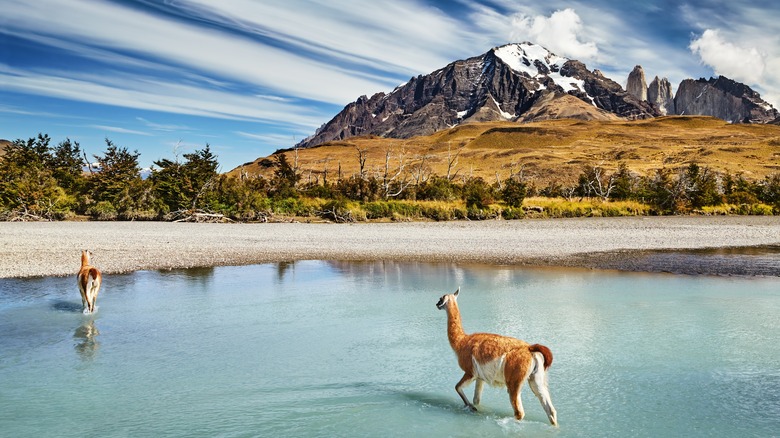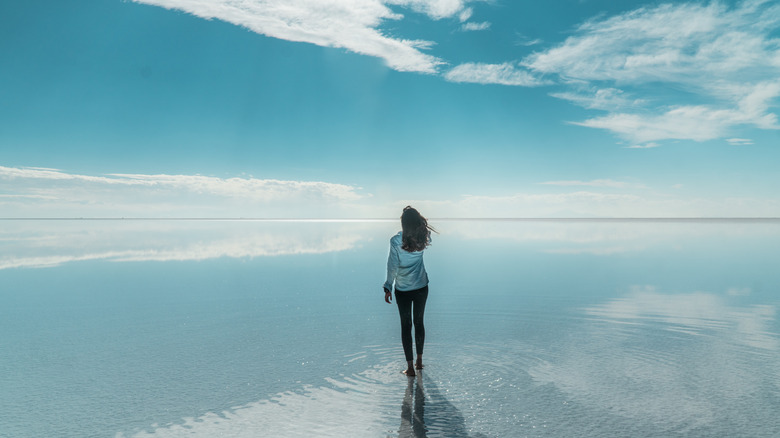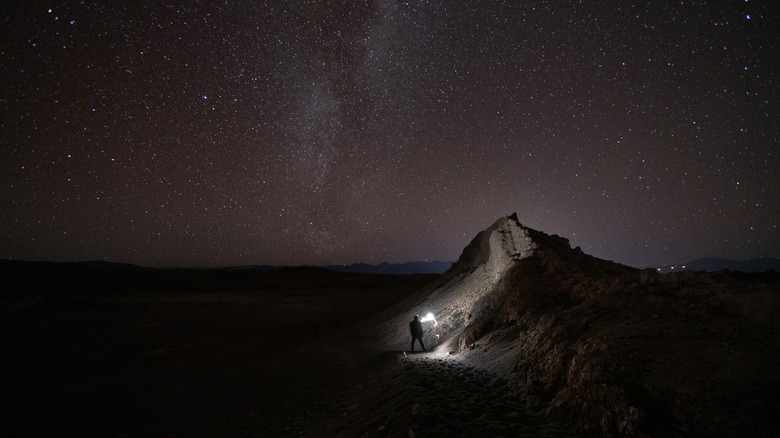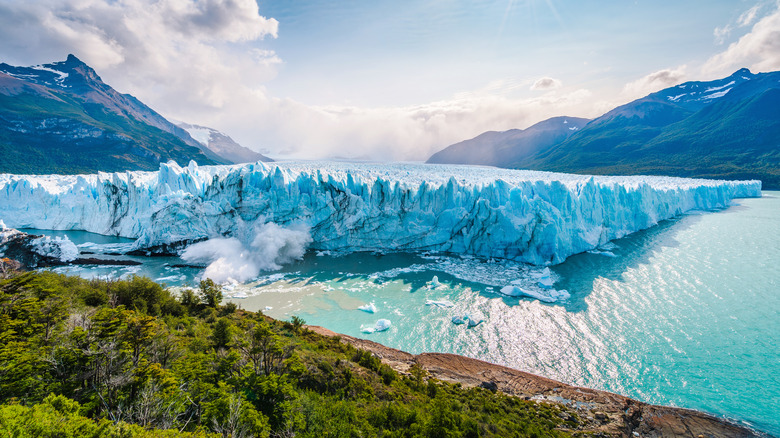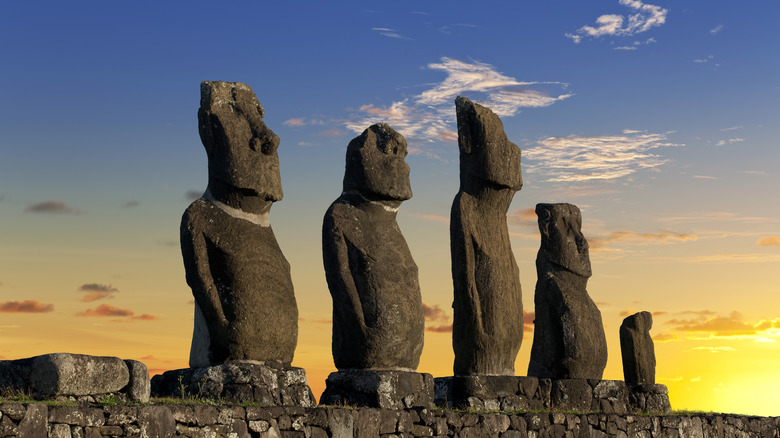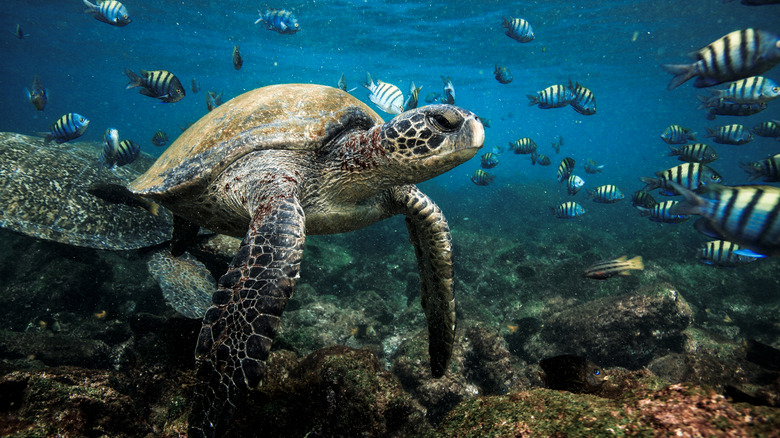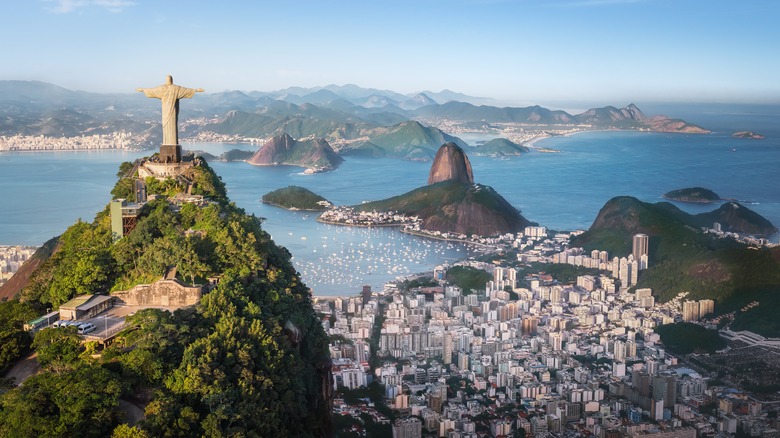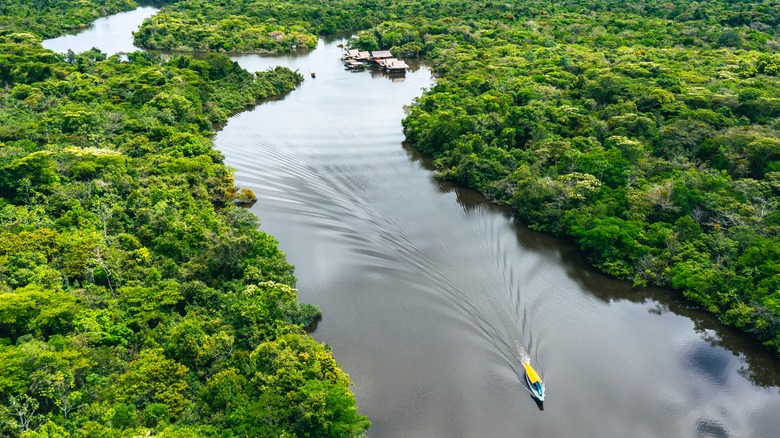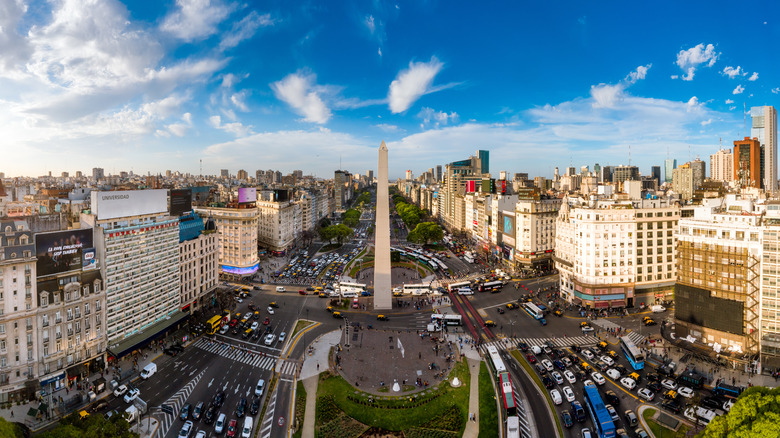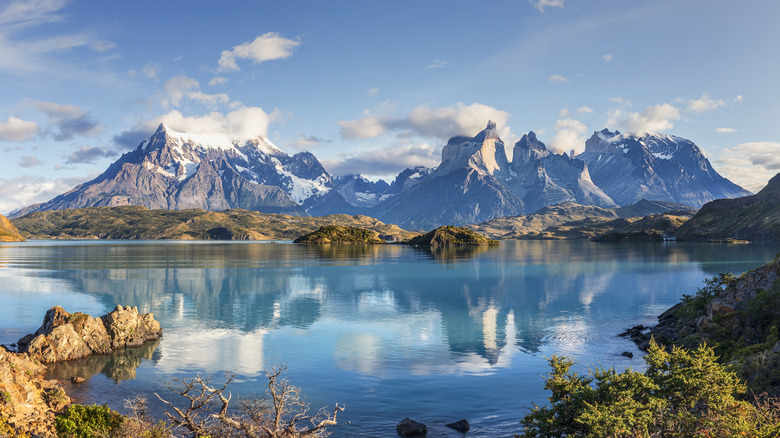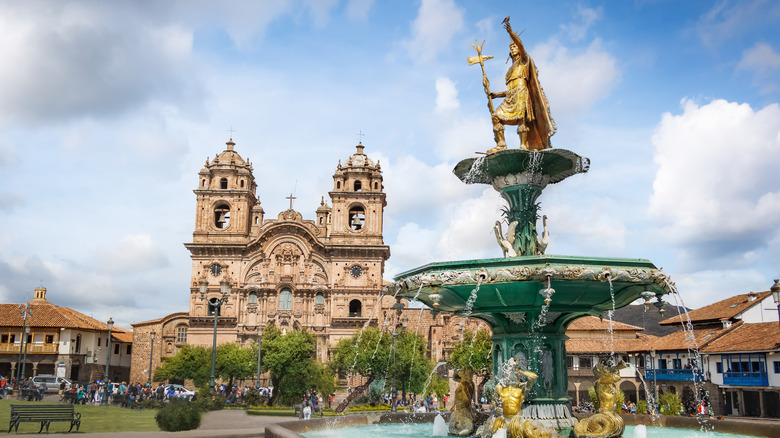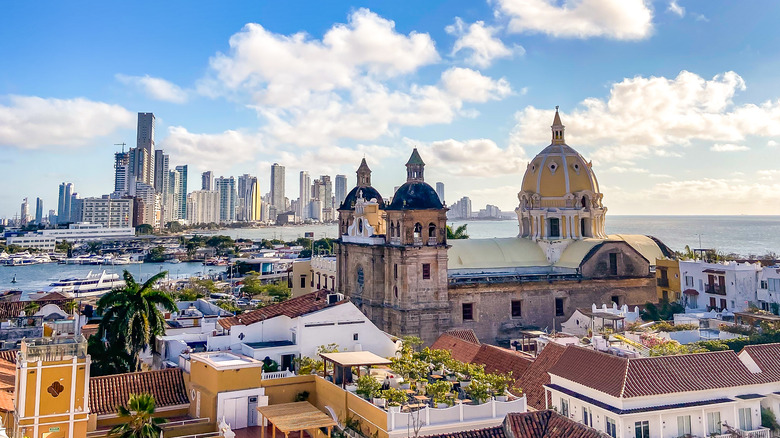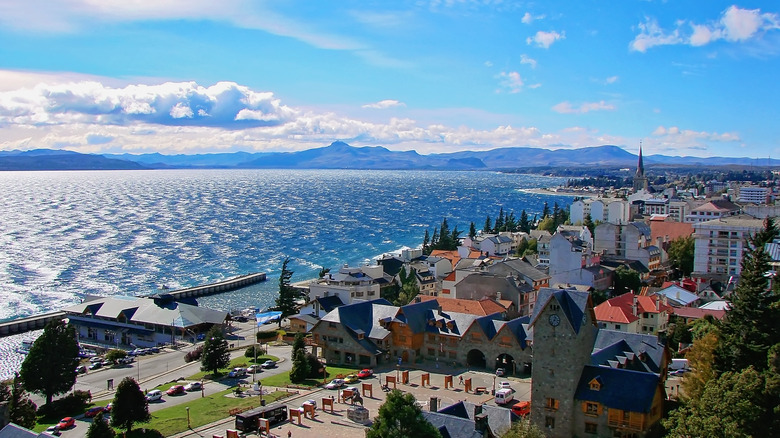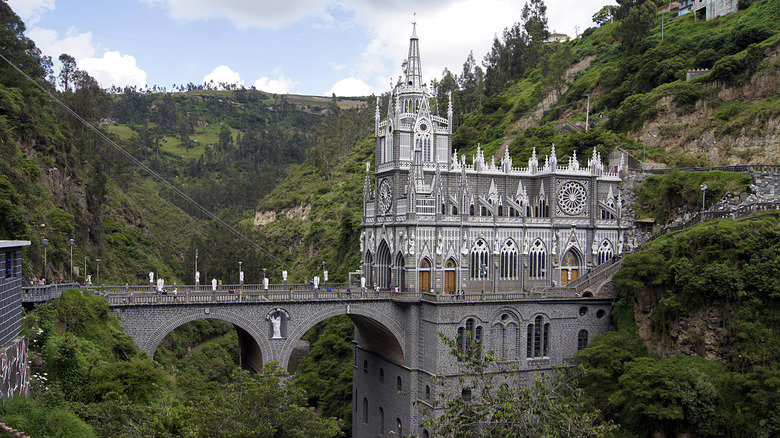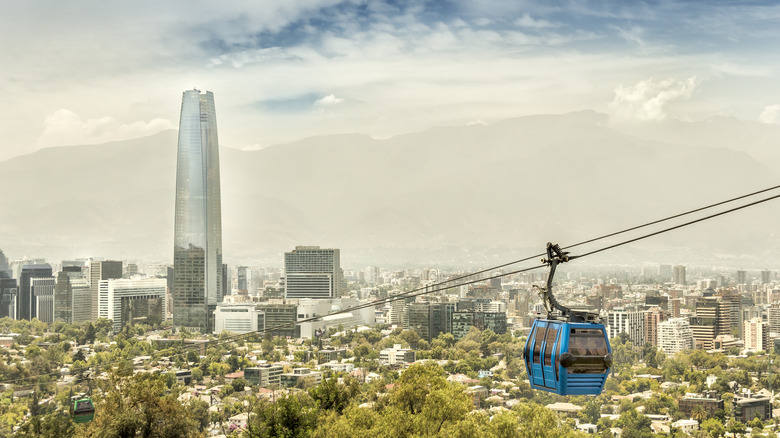Beautiful South American Destinations To Visit In January, According To Travelers
With 12 countries under its sun, South America is one of the most untouched continents on the planet. As a result, less experienced roamers may find the journey a far greater challenge than, say, Europe or North America. However, if you thrive on an adventure without a safety net, then the wild diversity of these countries could change your life for the better, thanks to some of the highest-regarded tourist destinations on the map. This includes more than 70 UNESCO World Heritage Sites and two of the New Seven Wonders of the World.
The following list was compiled from travelers' firsthand experiences, but please remember that each entry was explicitly chosen for the month of January. For example, while your friends may urge you to visit Angel Falls, you will not feel the full force of the waterfall during this dry month. Similarly, Lake Titicaca is an essential South American spot, but the heavy January rainfall will bury your fun beneath piles of mud. That said, never fear, for there are plenty of exciting alternatives to start your year with a bang, and that journey begins right here.
Salar de Uyuni, Bolivia
Like anything in life, if you want the best Instagram photos, you'll have to work for them. Salar de Uyuni's remote location likely means days of travel whether you're coming from Peru, Chile, Argentina, or Bolivia. And even then, the only reliable factor of the bus routes is that they will be reliably delayed.
But no matter your hardships, the victory will be worth every minute. Salar de Uyuni is the world's most expansive salt flat and is often considered Bolivia's dreamiest landscape. This rings especially true if you visit from January to March. During these months, the rainfall transforms the horizon into a vast mirror, creating a reflective optical illusion so spectacular that you won't trust your eyes. And once you've filled your camera, you can relax in one of their hotels made entirely out of salt. These architectural splendors are as impressive as they are impractical, each disintegrating within 10 to 15 years before the building process starts all over again.
Valle de la Luna, Chile
The name Valle de la Luna means "Valley of the Moon," and considering the attention that NASA has focused on the terrain, it makes a lot of sense. Situated in the Atacama Desert, this area is the second driest place on the planet, topped only by Antarctica. There are patches of ground here that have not seen a single raindrop in over 500 years. Due to this arid landscape and jagged wind-carved rocks, its otherworldly atmosphere proved the perfect spot for scientists to test their Mars rover prototype.
If these apocalyptic daytime conditions don't impress you, then the stargazing by night certainly will. Because of its high altitude and lack of pollution, astronomers around the world use this region to dive into the dark skies, the Atacama Desert is praised as an Astro-tourist paradise. That said, temperatures drop substantially over the winter; hence, it is advised to venture this way only during the warmer months, which, thankfully, include January.
Perito Moreno Glacier, Argentina
While we can easily see the threat of global warming through our withering glaciers, Perito Moreno is fighting against the odds and is actually growing, reportedly up to 10 feet a day! And, as it already stands at close to 19 miles in length, it is further recognized as a part of the world's third-largest reserve of fresh water. Such a unique force of nature is a thrill to see, but as it's far down south into the Patagonia region, you will have to earn these stunning South American glacier views.
To make matters more confusing, the town of Perito Moreno is 370 miles north of the glacier and should not be part of your trip. Instead, aim for El Calafate as your base. The glacier is only around two hours from there, and your travel options are plentiful, from buses to taxis and all the hitchhiking between. As for the best time of year to visit, there are pros and cons to any month you decide. On that token, the summer months (November to March) offer the rare spectacle of seeing pieces of the ice wall cracking off and tumbling into the water, at times up to 250 feet in height.
Rapa Nui (Easter Island), Chile
There is a short but definite list of essential locations on every explorer's itinerary, and Rapa Nui (also known as Easter Island) is always one of those entries. The primary appeal is its collection of nearly 1,000 moai statues, which have captured the world's imagination as some of the most recognizable sculptures in history. Regarding the monumental size of these creations (the biggest one weighs 82 tons), the debate about how the Rapa Nui people managed to move these pieces remains inconclusive, making it one of the most mysterious places on the planet.
Easter Island is officially a part of Chile, but as it lies 2,222 miles away, it technically falls in the Oceania region rather than South America. Accordingly, visiting the island is a challenging feat and will cost you. Your best bet is to catch a flight from Santiago with LATAM Airlines, which takes the journey two to three times a week. January is a month of scorching temperatures, but it is the ideal time to enjoy the sun rising over the largest row of statues, the Ahu Tongariki.
Galápagos Islands, Ecuador
If you crave remote holidays bursting with weird nature, the Galápagos Islands are the place for you. The climate here is so unique that you will find hundreds of plant and animal species exclusive to the region, from giant tortoises and iguanas to land snails and insects. Due to such a distinctive environment, the islands are known as a "living museum and showcase of evolution." Just ask Charles Darwin, who developed his natural selection theories when observing the Galápagos wildlife in 1835.
One could easily devise an excuse to visit the islands at any time of the year, but January has some convincing arguments. For starters, the water will be warm, which makes its world-famous snorkeling and scuba diving activities all the more pleasant. But perhaps the most exciting event is that the green sea turtles and giant tortoises lay their eggs this month, meaning you may catch a glimpse of these magnificent reptiles preparing their nests.
Rio de Janeiro, Brazil
South America's remote paradise locations are its specialty. But for those who also appreciate the vibrance of a city, there is nowhere on this continent with as much fire in its belly as Rio de Janeiro. Moreover, its landmarks rival the most celebrated our planet has to offer, including world-famous beaches like Copacabana, the 360-degree view from Sugarloaf Mountain, and, of course, Christ the Redeemer, one of the New Seven Wonders of the World. Unfortunately, its negative reputation for criminal behavior is not unfounded, and you'll have to keep your wits about you. That said, some visitors argue that the danger fuels the excitement of the experience.
January is peak summer, so it's perfect for those who love hot ocean days and city life bursting with thrilling celebrations. However, if you can hang around until February, the passionate chaos will amplify to record levels. That is when Rio Carnival, the biggest carnival on our globe, comes to town.
The Amazon Rainforest
Affectionately praised as "the lungs of the planet," the Amazon Rainforest is bigger than the imagination can comprehend. At 2.72 million square miles, it covers around 40% of South America, and while most of it spreads across Brazil, it touches eight countries in total. Try as hard as you like; you'll never see all of it.
However, many organized exploration options are available that will not only give you a feel for this wild terrain but also keep you away from potential danger. Catching a boat cruise down the Amazon River is a standard favorite, where you can visit the small indigenous villages along the way to learn about their customs. There is also the 550-yard canopy walkway that sways 115 feet above the land, presenting you with an unmatched view of the junglescape. And while January may be approaching the wet season, the short bursts of rain work to your advantage, as that's when more creatures come out to play. Just make sure you can identify the most dangerous animals in the Amazon, and you'll be fine!
Buenos Aires, Argentina
January is tourist season in Argentina, but there is a good reason for that. The summertime temperature sets the country in motion, and there is no better representation of this buzz than its capital, Buenos Aires. The sunshine pumps additional energy into the already highly active nightlife, with somewhere to party every night of the week. Meanwhile, the hot days are best spent in your most comfortable walking shoes, casually strolling through the colorful neighborhoods featuring such talented murals that street art tours have been popular for well over a decade.
Buenos Aires has long earned its reputation as a melting pot of cultures and is known as one of the continent's most diverse cities. Couple this with its European-inspired architecture, and there may be moments you completely forget which hemisphere you are in! It's no wonder it is nicknamed the "Paris of South America." It is so well-loved, in fact, that in 2012, this city boasted more visitors than any other metropolis on the continent.
Torres del Paine National Park, Chile
Chile is considered the southernmost country on the planet, with the Patagonia region as low as the Americas can go. This geographic truth birthed the End of the World Route, where adventurers check out certain attractions to conquer this bottom part of the globe. The list is not official but always includes Torres del Paine, a national park so revered that it has been lauded as the Eighth Wonder of the World.
Torres translates to "towers" in Spanish, and Paine translates to "blue" in the indigenous Tehuelche language, giving us "Towers of Blue." The name fits due to the park's distinct Three Towers granite peaks, but it can also apply to any direction you look. Indeed, Torres del Paine is 448,283 acres of scenic bliss, known for its mountains, glaciers, and immense bodies of water. January is the best month to maximize these views, as the skies are at their clearest, but only if you don't mind the summer tourist season bustle.
Cusco, Peru
The Sacred Valley is one of the most rewarding journeys any explorer can take. But while every list focuses on the Machu Picchu end goal, you may regret skipping over the capital of the Inca Empire, Cusco. With a rich history, winding streets to explore, and endless markets, there's such a wealth of cultural experience here that you might feel like you're dreaming. Then again, that could also be the 11,150-foot altitude messing with your brain, known to dizzy even the most seasoned travelers, some even fainting on the spot!
If you prepare for Cusco's high altitude and can handle some brief showers during the day, then January is many sightseers' preferred month due to the quietened off-season calm. And while you're here, pay attention to those tour guides offering packages to Rainbow Mountain. Compare their prices and choose the most reasonable for a day trip of unbelievable natural magic. However, please do your best to leave before February, as this is the wettest month, turning the area into such a slippery danger zone that several treks shut down.
Cartagena, Colombia
January is Colombia's dry season, bringing those sunny days above your step — perfect weather to explore the second-largest city in the Caribbean region, Cartagena. Your reasons for visiting may vary but should include its electric nightlife, idyllic beaches, and, most notably, its historical relevance. In particular, the town center played a pivotal role in the Spanish empire, with many political and economic decisions formed here from the 16th to the 18th centuries. As a result, the Spanish built almost 7 miles of defensive walls around the area, still recognized as some of the most impressive fortifications in South America today. This fancy fact earned the city that revered UNESCO World Heritage Site status.
The fun doesn't have to end at Cartagena, either. If you're looking for a tranquil break from the chaos, a one-hour boat ride will take you to the shores of the Rosario Islands, where snorkeling around colorful coral reserves and witnessing tear-inducing sunsets are a part of daily life. But if you're hoping to stay the night in this paradise, booking your accommodation in advance is recommended because options are limited.
San Carlos de Bariloche, Argentina
San Carlos de Bariloche is renowned for its skiing culture, and tourists flock here to experience these snowy mountains, which include one of the southern hemisphere's largest ski resorts, Cerro Catedral. Such a globally revered reputation makes for frantically busy winter months (June to September), so much so that most visitors are unaware of the countless other activities one can enjoy during the summer.
January is a pleasantly warm period, which not only comes with off-season peacefulness but is also the ideal time to embark on the magical treks available. As you're situated at the foothills of the Andes (the highest mountain range outside Asia), expect towering rocks as you've never seen them before. Additionally, there are plenty of rivers to raft, horses to ride, and birds to watch. But for the bravest adventurers, you could swim in one of their lakes, which are icy cold all year round due to the melting snow.
Sanctuary of Las Lajas, Colombia
Even if you're not religious, the Sanctuary of Las Lajas is a sight to behold with a story to tell. The legend begins centuries ago when a mother and her mute daughter sought shelter from a vicious storm in a cave. Here, the daughter witnessed the image of The Virgin Mary on one of the rocks and was instantly cured of her ailment, shouting "Look!" at her mother. Whether you believe this tale or not is irrelevant because the people of the area sure did, constructing this Gothic Revival-style masterpiece in that exact spot, dubbing the building "a miracle of God in the abyss." It is considered one of the most beautiful churches in the world, working as a pilgrimage site where Christians make the mission from every corner of the globe.
January is the ideal month to visit because it falls out of the rainy season. Furthermore, if you can brave the squish of crowds, you may want to attend the church services on the 15th and 16th of January, as that is when their anniversary celebrations take place.
Santiago, Chile
Chile's capital, Santiago, is often underutilized as a stopover point, with visitors landing at the airport only to rush off in another direction. Certainly, air traffic routes make it a convenient location, but to touchdown without exploring the varied gifts this city offers is a waste of possibilities. Perhaps the city's most striking characteristic is the juxtaposition of its skyline, where neoclassical architecture sits near stylish skyscrapers while expansive mountains paint the background. Similarly, vineyards surround Santiago, and it only takes a short drive to reach the Pacific Ocean.
But even without leaving the city, you'll find more culture than you need, from history museums to art galleries and theatre productions. There is also the all-important Plaza de Armas, known as "the heart of Santiago," which is essential viewing. So, while this spot can happily function as your Chilean base, it should be regarded as a highlight in its own right. January is an excellent month to maximize your visit due to the extended daylight and warmer temperatures working in your favor.
